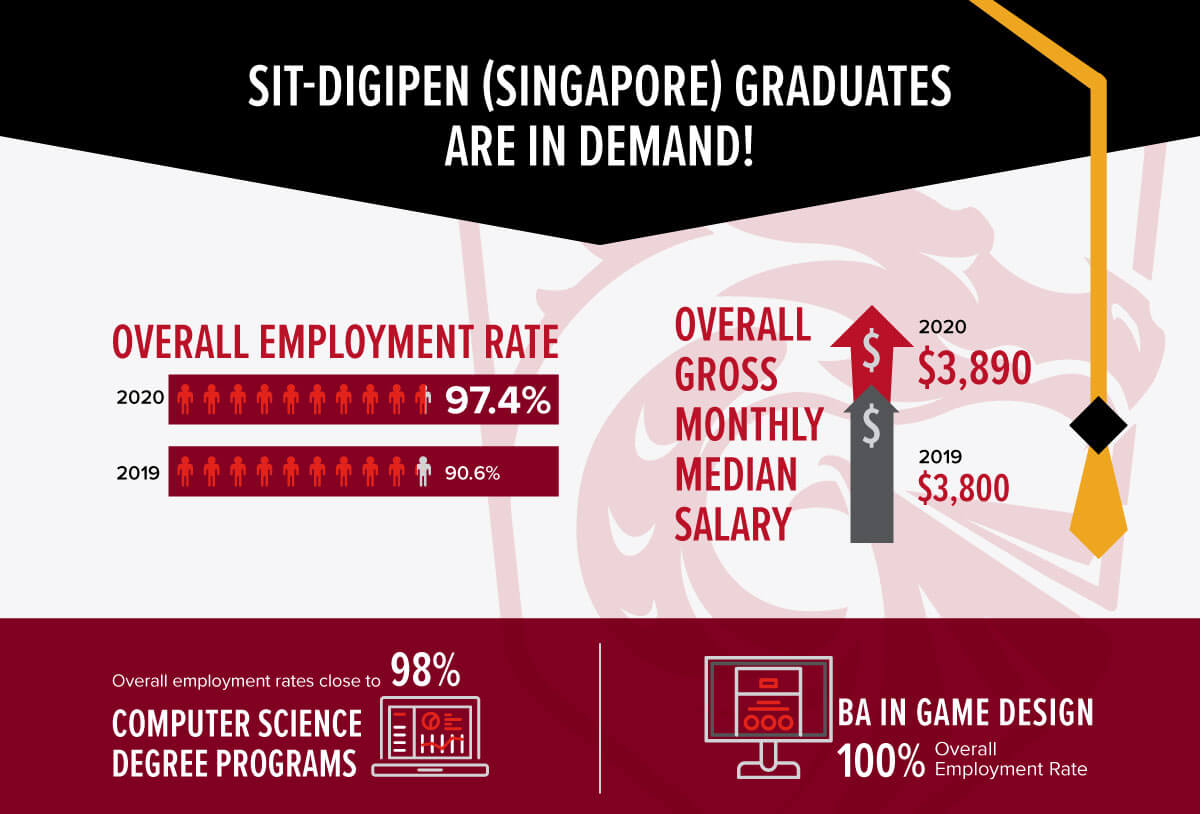
| Year of GES | Overall Employment Rate | Gross Monthly Mean Salary | Gross Monthly Median Salary | |
|---|---|---|---|---|
| Entire Graduate Cohort* | 2020 | 97.4% | $3,884 | $3,890 |
| 2019 | 90.6% | $3,832 | $3,800 | |
| BS in Computer Science in Real-Time Interactive Simulation | 2020 | 97.6% | $4,399 | $4,200 |
| 2019 | 100% | $4,474 | $4,400 | |
| BS in Computer Science and Game Design | 2020 | 97.7% | $3,974 | $4,000 |
| 2019 | 91.3%^ | $3,791^ | $3,800^ | |
| BEng in Systems Engineering (ElectroMechanical Systems) | 2020 | 95.7% | $4,114 | $4,185 |
| 2019 | 95.2%^ | $4,024^ | $3,975^ | |
| BA in Game Design | 2020 | 100%^ | $3,575^ | $3,500^ |
| 2019 | 83.3%^ | $3,167^ | $3,220^ | |
| BFA in Digital Art and Animation | 2020 | 97.1% | $2,862 | $2,887^ |
| 2019 | 81.3%^ | $3,051 | $3,150^ |
^ Data is based on a sample size of fewer than 30 respondents.
* Entire Graduate Cohort refers to the total of DigiPen (Singapore) and SIT-DigiPen (Singapore) graduates for the 2020 JAUGES. Source: https://www.moe.gov.sg/post-secondary/overview/autonomous-universities/sit
Graduates from SIT-DigiPen (Singapore) continue to be in high demand with good employment rates and competitive starting salaries, despite the poor economy in 2020. The latest 2020 Joint Autonomous University Graduate Employment Survey (JAUGES) findings revealed that 97.4% [1] of SIT-DigiPen (Singapore) graduates in the labor force [2] were employed, up from the 90.6% figure last year. The gross monthly median salary [3] also increased from $3,800 to $3,890.
Leading the pack for overall employment were BA in Game Design (BAGD) graduates, with 100.0% employment, up from 83.3% last year. The strength of BAGD graduates lies in their versatility. On top of having a sound understanding of UX design principles, students in the program are trained on how to design and build immersive software. These skills come together to enable them to craft meaningful and interactive experiences and applications in roles such as product management, UX/UI design, and interactive design.
In line with aggressive hiring trends in the technology sector, software engineering expertise continues to be highly sought after. Graduates from both the BS in Computer Science in Real-time Interactive Simulation and BS in Computer Science and Game Design (BSCS GD) programs enjoyed overall employment rates close to 98%, while hiring for BEng in Systems Engineering (ElectroMechanical Systems) (SEEMS) remained comparable with last year’s results at 95.7%. Overall employment for BFA in Digital Art and Animation (BFA) graduates also rose to 97.1% this year, compared to 81.3% in 2019. Additionally, the number of BFA graduates in full-time permanent employment jumped from 50.0% to 70.6%.
Beyond the strong employment outcomes, surveyed graduates also commanded competitive starting salaries across all programs. BAGD graduates enjoyed the biggest rise in gross monthly median salary from $3,220 to $3,500 this year. BSCS GD graduates also saw an increase from $3,800 to $4,000, and SEEMS graduates continued to do well with an increase from $3,975 to $4,185 — building upon the strong precedent that was set by the inaugural batch which graduated in 2019.
Amidst the pandemic in 2020, SIT-DigiPen (Singapore) graduates have done well, especially in the area of employment. The high employment rates and competitive salaries continue to reflect strong demand for our graduates who are trained to excel in the digital economy. We will continue to build up talent pools in the computer science, embedded systems engineering, UX/UI design, and digital art and animation focus areas.
[1] This figure includes SIT-DigiPen (Singapore) graduates who were enrolled in the SGUnited Traineeships (SGUT) Programmes.
[2] Graduates in the labour force refer to those who are working or not working but actively looking and available for work.
[3] Amongst graduates in full-time permanent employment, i.e. employment of at least 35 hours a week and where the employment is not temporary, including those on contracts of one year or more. Gross monthly salary comprises the basic salary, fixed allowances, over-time pay, commissions and other regular cash payments, before deductions of the employee’s CPF contributions and personal income tax. Employer’s CPF contributions, bonuses, stock options, other lump sum payments, and payments-in-kind are excluded.